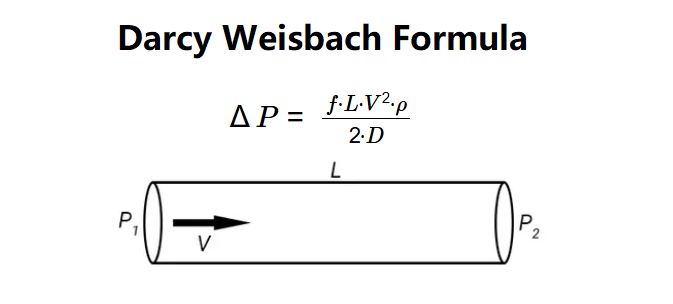1. What is Darcy-Weisbach Calculator?
Definition: This calculator computes the pressure loss (\( \Delta P \)) in a pipe due to friction, using the Darcy-Weisbach equation, based on the Darcy friction factor, pipe length, flow velocity, fluid density, and pipe diameter.
Purpose: It is used in fluid mechanics and engineering to analyze pressure losses in pipe flow systems, helping to design efficient piping networks for applications like water supply, HVAC, and industrial fluid transport.
2. How Does the Calculator Work?
The calculator uses the following formula:
- \( \Delta P = \frac{f \cdot L \cdot V^2 \cdot \rho}{2 \cdot D} \)
Where:
- \( f \): Darcy friction factor (dimensionless);
- \( L \): Pipe length (m);
- \( V \): Flow velocity (m/s);
- \( \rho \): Fluid density (kg/m³);
- \( D \): Pipe diameter (m);
- \( \Delta P \): Pressure loss (Pa).
Steps:
- Enter the Darcy friction factor (\( f \)) (dimensionless).
- Enter the pipe length (\( L \)) with its unit.
- Enter the flow velocity (\( V \)) with its unit.
- Choose the fluid density (\( \rho \)) by selecting a fluid or entering a custom density with its unit.
- Enter the pipe diameter (\( D \)) with its unit.
- Convert all inputs to base units (m for length and diameter, m/s for velocity, kg/m³ for density).
- Calculate the pressure loss: \( \Delta P = \frac{f \cdot L \cdot V^2 \cdot \rho}{2 \cdot D} \).
- Convert the pressure loss to the selected output unit and display the result, formatted in scientific notation if the absolute value is less than 0.001, otherwise with 5 decimal places.
3. Importance of Darcy-Weisbach Calculation
Calculating the pressure loss using the Darcy-Weisbach equation is crucial for:
- Pipe System Design: Determining the pressure drop in pipes to ensure adequate flow rates and select appropriate pumps or pipe sizes.
- Energy Efficiency: Minimizing energy losses due to friction in fluid transport systems, such as in water distribution or HVAC systems.
- Performance Analysis: Evaluating the performance of piping networks in various applications, such as industrial fluid transport, irrigation, and fire protection systems.
4. Using the Calculator
Example 1: Calculate \( \Delta P \) for water flowing through a pipe with the following properties:
- Darcy Friction Factor: \( f = 0.02 \);
- Pipe Length: \( L = 100 \, \text{m} \);
- Flow Velocity: \( V = 2 \, \text{m/s} \);
- Fluid: Water (\( \rho = 1000 \, \text{kg/m}^3 \));
- Pipe Diameter: \( D = 0.1 \, \text{m} \);
- Pressure Loss: \( \Delta P = \frac{0.02 \times 100 \times (2)^2 \times 1000}{2 \times 0.1} = 40000 \, \text{Pa} \);
- Result: \( \Delta P = 40000.00000 \, \text{Pa} \).
Example 2 (Custom Density, Different Units): Calculate \( \Delta P \) with the following properties:
- Darcy Friction Factor: \( f = 0.025 \);
- Pipe Length: \( L = 50 \, \text{ft} \);
- Flow Velocity: \( V = 5 \, \text{ft/s} \);
- Fluid Density: \( \rho = 1.2 \, \text{g/cm}^3 \);
- Pipe Diameter: \( D = 4 \, \text{in} \);
- Convert units: \( L = 50 \times 0.3048 = 15.24 \, \text{m} \), \( V = 5 \times 0.3048 = 1.524 \, \text{m/s} \), \( \rho = 1.2 \times 1000 = 1200 \, \text{kg/m}^3 \), \( D = 4 \times 0.0254 = 0.1016 \, \text{m} \);
- Pressure Loss: \( \Delta P = \frac{0.025 \times 15.24 \times (1.524)^2 \times 1200}{2 \times 0.1016} \approx 5208.49 \, \text{Pa} \);
- Result (in psi): \( \Delta P = 0.75499 \, \text{psi} \).
5. Frequently Asked Questions (FAQ)
Q: What does the Darcy friction factor \( f \) represent?
A: The Darcy friction factor (\( f \)) is a dimensionless quantity that accounts for the friction losses in a pipe due to surface roughness and flow characteristics. It depends on the Reynolds number and the pipe's relative roughness.
Q: Why does the pressure loss depend on the pipe diameter?
A: The pressure loss (\( \Delta P \)) is inversely proportional to the pipe diameter (\( D \)) in the Darcy-Weisbach equation. A smaller diameter increases the friction and thus the pressure loss for the same flow velocity.
Q: Can this calculator be used for gases?
A: Yes, the Darcy-Weisbach equation applies to both liquids and gases, as long as the appropriate fluid density (\( \rho \)) and flow velocity (\( V \)) are provided. However, the friction factor (\( f \)) may vary depending on the flow regime (laminar or turbulent) and fluid properties.
Darcy-Weisbach Calculator© - All Rights Reserved 2025
 Home
Home
 Back
Back
